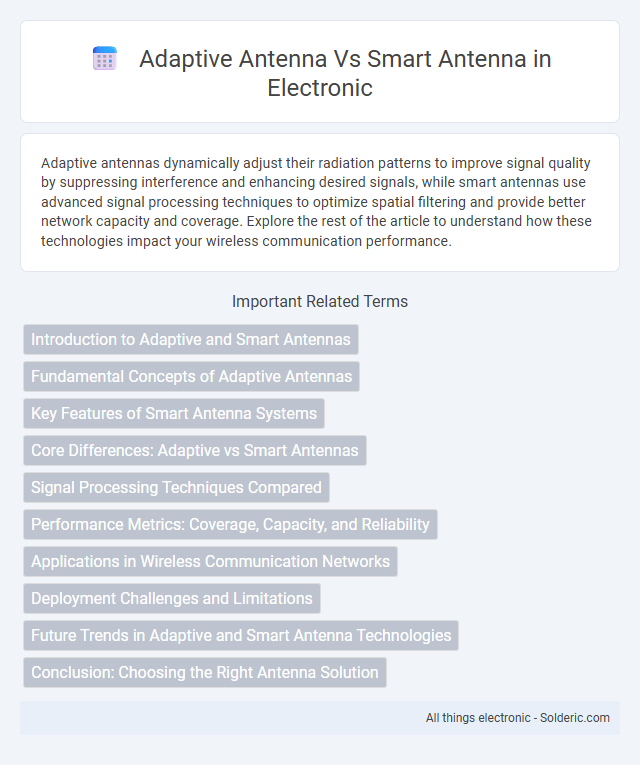Adaptive antennas dynamically adjust their radiation patterns to improve signal quality by suppressing interference and enhancing desired signals, while smart antennas use advanced signal processing techniques to optimize spatial filtering and provide better network capacity and coverage. Explore the rest of the article to understand how these technologies impact your wireless communication performance.
Comparison Table
| Feature | Adaptive Antenna | Smart Antenna |
|---|---|---|
| Definition | Antenna system that dynamically adjusts beam patterns to minimize interference. | Advanced antenna system using signal processing algorithms for optimized signal quality. |
| Functionality | Adapts beam direction based on real-time environment changes. | Combines adaptive beamforming and spatial diversity to maximize performance. |
| Technology | Primarily beamforming with feedback from received signals. | Incorporates digital signal processing and multi-antenna arrays. |
| Applications | Used in radar, wireless communication to reduce interference. | Widely used in cellular networks, Wi-Fi, and MIMO systems. |
| Advantages | Improves signal-to-interference ratio and reduces multipath. | Enhances throughput, coverage, and spectral efficiency. |
Introduction to Adaptive and Smart Antennas
Adaptive antennas dynamically adjust their radiation patterns to reduce interference and enhance signal quality by continuously monitoring the radio environment. Smart antennas combine multiple antenna elements with advanced signal processing algorithms to improve wireless communication performance through spatial diversity and beamforming techniques. Both technologies optimize wireless network capacity, coverage, and reliability by intelligently directing signals toward desired users while minimizing undesired signals.
Fundamental Concepts of Adaptive Antennas
Adaptive antennas utilize real-time signal processing techniques to dynamically adjust their radiation patterns for optimizing signal reception and interference suppression. These antennas employ algorithms such as beamforming and null steering to adaptively respond to changing signal environments, enhancing communication quality and system capacity. Understanding these fundamental concepts helps you optimize wireless network performance by intelligently directing antenna arrays based on spatial signal characteristics.
Key Features of Smart Antenna Systems
Smart antenna systems integrate adaptive antenna technology with digital signal processing to enhance wireless communication by dynamically adjusting beam patterns for improved signal quality and reduced interference. Key features include spatial filtering, multiple-input multiple-output (MIMO) capabilities, and real-time signal direction estimation, enabling optimized coverage and increased network capacity. Your wireless system benefits from enhanced spectral efficiency and robust performance in multipath and high-mobility environments through these intelligent features.
Core Differences: Adaptive vs Smart Antennas
Adaptive antennas dynamically adjust their radiation patterns based on real-time signal environment changes, using algorithms to minimize interference and enhance signal quality. Smart antennas encompass adaptive antennas but integrate additional technologies such as spatial diversity and multiple input multiple output (MIMO) systems to optimize performance further. Your communication system benefits from adaptive antennas' focused interference reduction, while smart antennas provide broader capabilities in signal processing and directionality.
Signal Processing Techniques Compared
Adaptive antennas use real-time signal processing techniques like beamforming and spatial filtering to dynamically adjust radiation patterns, enhancing signal quality by minimizing interference and fading. Smart antennas incorporate advanced algorithms such as direction of arrival (DoA) estimation and adaptive null steering to optimize signal reception and transmission based on environmental changes. Your system's performance depends on selecting appropriate signal processing methods tailored to the specific adaptive or smart antenna technology used for effective wireless communication.
Performance Metrics: Coverage, Capacity, and Reliability
Adaptive antennas dynamically adjust their beam patterns to enhance coverage and capacity by focusing signals towards users, reducing interference, and improving signal quality, resulting in higher system reliability. Smart antennas incorporate advanced signal processing techniques like beamforming and spatial filtering to optimize coverage area and network capacity, ensuring robust connections and minimizing dropped calls. Your network's performance in coverage, capacity, and reliability can significantly improve by leveraging adaptive antennas for real-time adjustments and smart antennas for intelligent signal management.
Applications in Wireless Communication Networks
Adaptive antennas improve wireless communication networks by dynamically adjusting their radiation patterns to mitigate interference and enhance signal quality, making them ideal for cellular systems and point-to-point microwave links. Smart antennas integrate multiple antenna elements with signal processing algorithms to facilitate spatial filtering and beamforming, significantly boosting capacity and coverage in 4G, 5G, and Wi-Fi networks. Both technologies optimize spectrum efficiency and reduce multipath fading in environments such as urban, indoor, and high-mobility scenarios.
Deployment Challenges and Limitations
Adaptive antennas face deployment challenges such as complex signal processing requirements and higher costs due to the need for real-time adjustments to dynamic environments. Smart antennas, while offering enhanced spatial filtering and improved spectral efficiency, encounter limitations including increased system complexity and the necessity for advanced algorithms to accurately interpret signal patterns. Your network performance may be affected by these factors, requiring careful planning and resource allocation to optimize antenna deployment.
Future Trends in Adaptive and Smart Antenna Technologies
Future trends in adaptive and smart antenna technologies emphasize the integration of machine learning algorithms to enhance beamforming accuracy and interference mitigation in 5G and beyond networks. Innovations in massive MIMO and reconfigurable intelligent surfaces further drive improvements in spectral efficiency and energy consumption. Continued advancements in software-defined radio platforms enable real-time adaptability and seamless integration with IoT and edge computing applications.
Conclusion: Choosing the Right Antenna Solution
Adaptive antennas dynamically adjust their radiation patterns to enhance signal quality and reduce interference, making them ideal for environments with rapidly changing signal conditions. Smart antennas integrate multiple adaptive techniques with advanced signal processing to improve overall system capacity and user experience in complex wireless networks. Selecting the right antenna solution depends on specific application needs, with adaptive antennas suited for targeted interference mitigation and smart antennas preferred for maximizing network efficiency and performance.
adaptive antenna vs smart antenna Infographic

 solderic.com
solderic.com